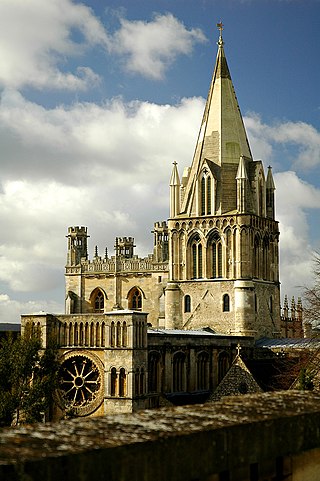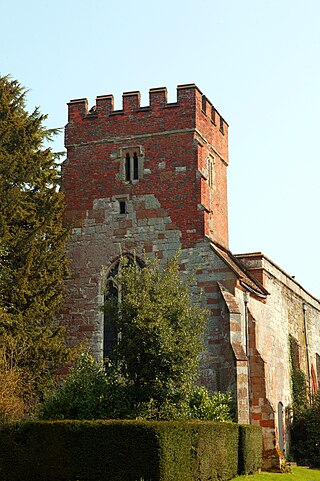In Christianity, a collegiate church is a church where the daily office of worship is maintained by a college of canons, a non-monastic or "secular" community of clergy, organised as a self-governing corporate body, headed by a dignitary bearing a title which may vary, such as dean or provost. In its governance and religious observance a collegiate church is similar in some respects to a cathedral, although a collegiate church is not the seat of a bishop and has no diocesan responsibilities. Collegiate churches have often been supported by endowments, including lands, or by tithe income from appropriated benefices. The church building commonly provides both distinct spaces for congregational worship and for the choir offices of the canons.
A royal peculiar is a Church of England parish or church exempt from the jurisdiction of the diocese and the province in which it lies, and subject to the direct jurisdiction of the monarch or, in Cornwall, of the Duke of Cornwall.

The Diocese of Oxford is a Church of England diocese that forms part of the Province of Canterbury. The diocese is led by the Bishop of Oxford, and the bishop's seat is at Christ Church Cathedral, Oxford. It contains more church buildings than any other diocese and has more paid clergy than any other except London.
A provincial episcopal visitor (PEV), popularly known as a flying bishop, is a Church of England bishop assigned to minister to many of the clergy, laity and parishes who on grounds of theological conviction, "are unable to receive the ministry of women bishops or priests". The system by which such bishops oversee certain churches is referred to as alternative episcopal oversight (AEO).

St Helen's Bishopsgate is an Anglican church in London. It is located in Great St Helen's, off Bishopsgate.

Barnwell is a suburb of Cambridge in England. The population of the Barnwell ward of Cambridge City Council at the 2011 census was 1,967. It lies northeast of the city, with Cambridge Airport located immediately to the east. It forms part of the ecclesiastical parish of St Andrew the Less and was the site of Barnwell Priory.
The Bishop of Ebbsfleet is a suffragan bishop who fulfils the role of a provincial episcopal visitor in the Church of England. From its creation in 1994 to 2022, the Bishop of Ebbsfleet served traditionalist Anglo-Catholic parishes that reject the ordination of women as priests and bishops. Since 2023, the bishop has served conservative evangelical parishes that reject the ordination and/or leadership of women due to complementarian beliefs.

The Cathedral Church of Saint Mirin in Paisley, dedicated to Saint Mirin the patron saint of Paisley, is the mother church of the Catholic Diocese of Paisley and is the seat of the Bishop of Paisley.
John Richards was a British Anglican bishop. He was the first Bishop of Ebbsfleet from 1994 to 1998.
Among the places of worship in the town and area of Malvern, Worcestershire are centres of dedication to many faiths and denominations. The town has 31 Christian churches with 11 belonging to the Church of England, ranging from low church to high Anglo-Catholic, two Roman Catholic, one Evangelical, and the others being Non-Conformist and other faiths. Its oldest place of worship is the almost cathedral sized parish church of Great Malvern Priory which is all that remains of the former 10th century abbey in central Malvern, which according to the Worcester Monastic Annals, work began in 1085. The chain of Malvern Hills lies in a north-south direction, thus posing a challenge for the architects of Christian churches located on the steep slopes, chancels being traditionally sited at the east end of the building. Many churches were built in the 19th century concomitant with the rapid expansion of the town due to its popularity as a spa. A few modern buildings such as St Mary's Church (1960) in Sherrard's Green, have been constructed in the second half of the 20th century, and some churches, notably St Andrews in Poolbrook, have had important modern extensions added during the first decade of the 21st century.

Wren's Cathedral, properly the Church of St Leonard and now a cathedral of the Communion of Evangelical Episcopal Churches, was originally the Lady Chapel of Wroxall Priory.

Christ Church Fulwood is a large conservative evangelical Anglican parish church of the Church of England situated in Fulwood, Sheffield, England. The Revd Canon Paul Williams was vicar at Christ Church from 2006 to 2021.

Jonathan Michael Goodall is a British Roman Catholic priest and a former Church of England bishop. From 2013 to 2021, he was Bishop of Ebbsfleet, a suffragan bishop who is the provincial episcopal visitor in the western half of the Province of Canterbury for those "within the spectrum of Anglican teaching and tradition" who are "unable to receive the ministry of women as bishops or priests". He was ordained a Catholic priest on 12 March 2022.

St Andrew the Great is a Church of England parish church in central Cambridge. Rebuilt in late Gothic style in 1843, it is a Grade II listed building. The church has a conservative evangelical tradition and participates in the Anglican Reform movement. The congregation includes Cambridge residents, overseas visitors and students.

The Church of St Giles is a Grade II*-listed church in Cambridge, England. It is a Church of England parish church in the Parish of the Ascension of the Diocese of Ely, located on the junction of Castle Street and Chesterton Road. It was completed and consecrated by the Bishop of Ely in 1875, to replace an earlier church founded in 1092. The church, which added "with St Peter" to its appellation when the neighbouring St Peter's Church became redundant, is home to both an Anglican and a Romanian Orthodox congregation and is used as a venue for concerts and other events. The church is kept open daily for visitors.

Our Lady of Sorrows Church is a Roman Catholic Parish church in Bognor Regis, West Sussex, England. It was built from 1881 to 1882 and designed by Joseph Stanislaus Hansom. It is situated on the corner of the High Street and Clarence Road, backing on to Albert Road, in the centre of the town. It was founded by the Servite Order and is a Grade II listed building.
The Bishop of Oswestry is a suffragan bishop of the Diocese of Lichfield who fulfils the role of a provincial episcopal visitor in the Church of England.

St Paul's, Cambridge is a Church of England parish church situated 0.8 miles (1.3 km) to the south east of the city centre of Cambridge, on the corner of St Paul's Road with Hills Road. St Paul's is part of the Cambridge South Deanery in the Anglican Diocese of Ely. The church is a Grade II Listed Building and has a place in the history of the Gothic Revival due to criticism from the Cambridge Camden Society in the first issue of The Ecclesiologist.

Our Lady and St Michael's Church also known as Our Lady Star of the Sea and St Michael's Church is a Roman Catholic Parish church in Workington, Cumbria, England. It was built in 1876 by the Benedictines. It is located on Bank Road and Banklands to the south west of the town centre. It was designed by E. W. Pugin in the Gothic Revival style and is a Grade II listed building.













